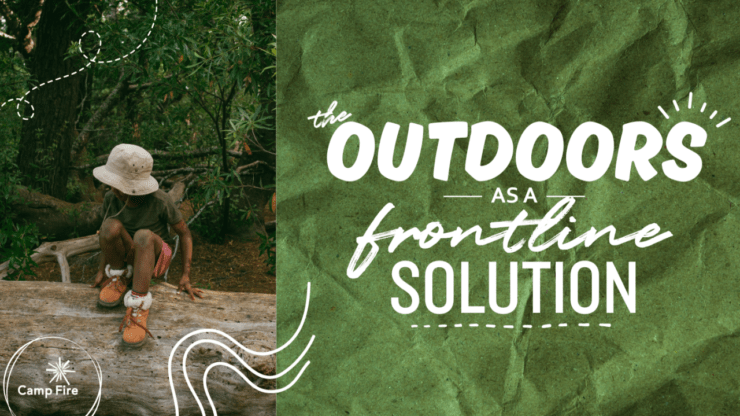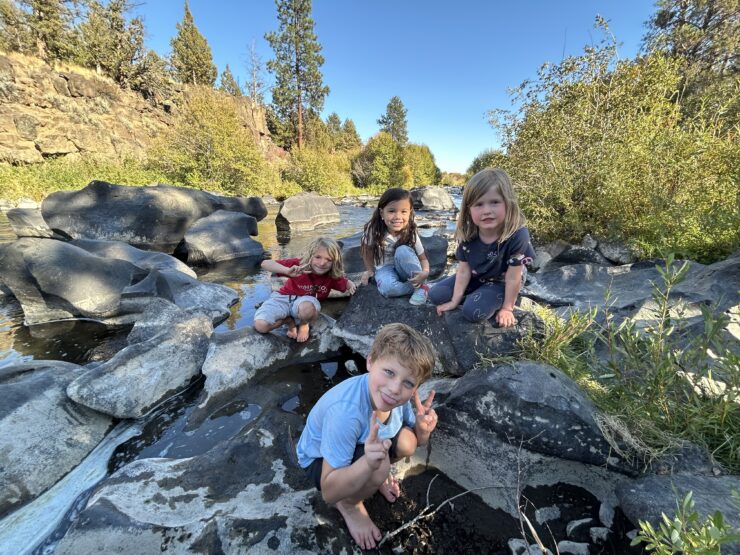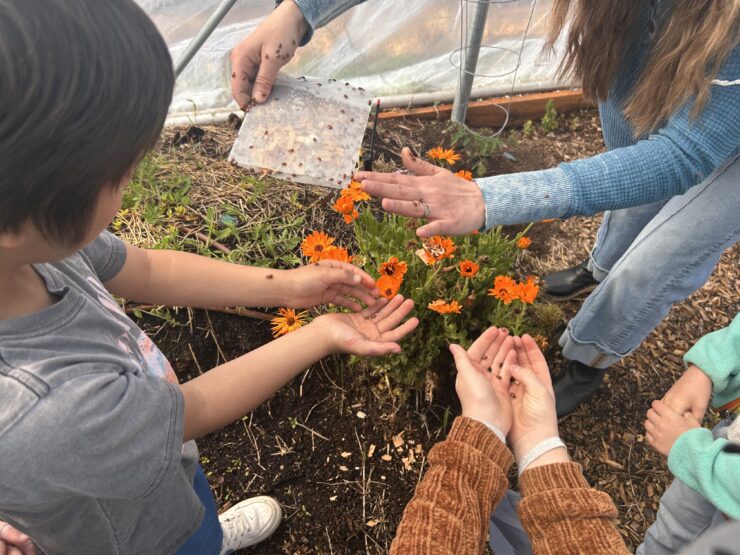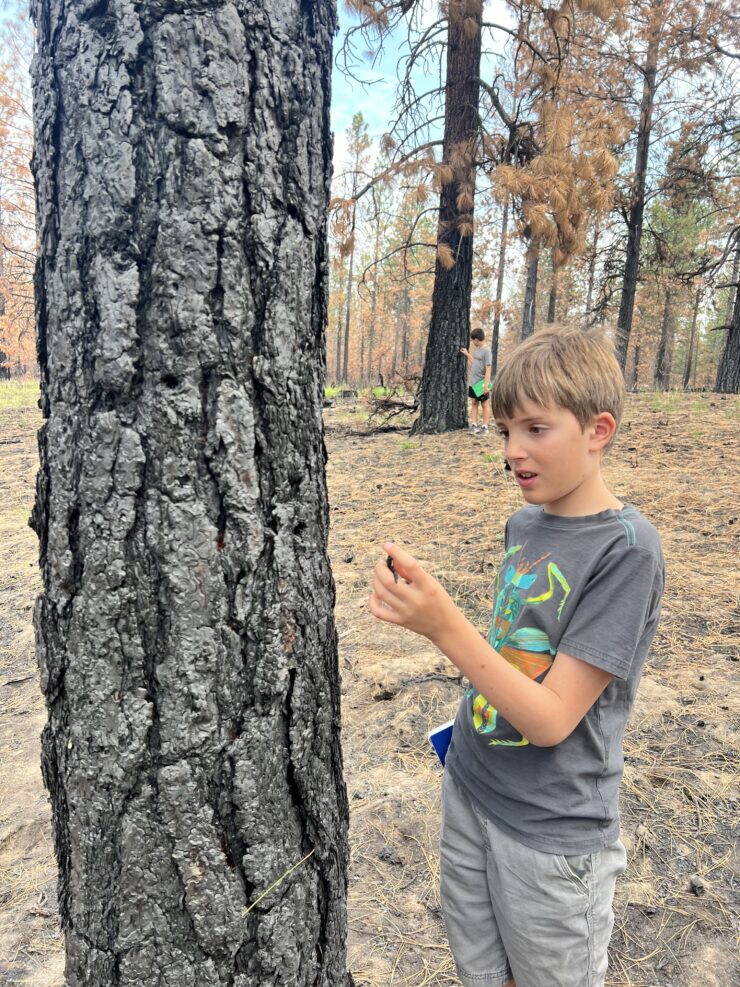More Than an Escape: The Outdoors as a Frontline Solution

“Go touch some grass.”
It’s a phrase often tossed out as a joke or jab when someone’s online too much or getting worked up over something that doesn’t matter.
But what if that phrase held more truth than we realize?
In the face of a growing youth mental health crisis, parents, educators, and practitioners are desperate for real, lasting solutions. Could the answer be as simple as getting outside?
Earlier this year, Camp Fire CEO Shawna Rosenzweig hosted a powerful panel at SXSW EDU exploring this very question. Alongside leaders from REI Co-op, the Alliance for Camp Health, and Native Americans in Philanthropy, the discussion explored how nature is more than a nice-to-have—it’s a core component of mental, emotional, and community health.
Here’s a look at some of the biggest takeaways from the conversation.

Youth scramble streamside at Camp Fire Afterschool in Bend.
The Premise and the Problem
The panel opened with a provocative question:
What if the key to young people’s wellbeing lies just outside our doors?
Right now, American kids spend an average of just four to seven minutes a day in unstructured outdoor play—and more than seven hours a day in front of screens. That disconnect is reflected in alarming mental health statistics:
· 1 in 5 young people are struggling with significant mental health issues.
· 3.4 million children report contemplating suicide on a regular basis.
· Youth of color and LGBTQ+ youth face even steeper challenges.
The reality is stark—and the gap between what we need and what we’re actually getting is only widening.
So what’s missing? One word: Outdoors. The idea that “fresh air helps” isn’t just anecdotal. A growing body of research—alongside centuries of Indigenous knowledge—shows us that connection with nature is one of the most effective ways to reduce stress, increase wellbeing, and foster a sense of belonging.
The Outdoors Is Not Just a Setting, It’s an Identity
Brittany Schulman, Senior Vice President of Programs at Native Americans in Philanthropy, offered a deeply personal and cultural perspective.
“For us, access to the outdoors isn’t recreational. It’s relational,” she shared.
Drawing on the 5 R’s of Indigenous values—Respect, Relationships, Responsibility, Reciprocity, Redistribution—Brittany described how integral nature is to a person’s identity, experience, and ancestral history.
For Native and Indigenous people, “When we talk about the outdoors, it’s not just a place we go to. It’s an extension of ourselves, our family, our entire environment. It’s not a luxury to go to the park. No, it’s a time to connect with my ancestors, with my future generations because it’s all a part of this place.”
When outdoor spaces are restricted or inaccessible—as they often are, even on lands promised through treaties—the consequences go beyond inconvenience. They are a severing of cultural, spiritual, and familial connection.
Barriers to Access and Participation
Even when nature is technically “available,” it’s not always welcoming or safe for everyone. Marc Berejka of REI highlighted a hard truth: “Not every outdoor space is safe for every person.” Whether due to systemic inequality, location, cost, or outright racism, as in the tragic killing of Ahmaud Arbery, marginalized communities often face invisible—and sometimes very visible—barriers to accessing nature. According to a study by the Trust for Public Land, 30% of the country lacks easy access to green space. This is especially true in lower-income, urban settings. In real numbers, that means 100 million Americans (including 28 million children) do not have a park within a 10-minute walk from home.
Even then, access on paper doesn’t always translate to access in practice, with countless “green” spaces being inaccessible due to crime, neglect, lack of transportation, or community mistrust.
It’s not enough to simply have parks or trails. The goal must be meaningful participation—where every person feels safe, welcomed, and included in outdoor spaces.

It's a ladybug lesson at No School Day Camp!
What Are We Modeling?
John Hamilton, Chief Strategy Officer at the Alliance for Camp Health, reminded us that young people take cues from adults. And right now, we’re modeling disconnection.
Adults average 11 hours a day on screens. That’s not just a lifestyle issue—it’s a legacy issue.
“When we say, ‘go outside,’ are we going with them?” he asked. “Are we helping them recognize their connection to nature and how they are feeling?” Programs like CampWell are helping organizations shift this narrative—training leaders and educators to create holistic, emotionally intelligent, and nature-connected experiences.
Nature-based group therapy, reflective transitions between school and aftercare, and intentional outdoor rituals are all part of a growing movement to make mental health support more proactive and human-centered.

Camp Fire's Ecology Engineers gets kids up close with nature and wildfire lessons!
From Research to Relationship
Marc spoke about the importance of pairing what we feel with what we can prove. Traditional knowledge tells us nature heals. Our bodies know that stepping outside to get some fresh air can make a world of difference in how we feel.
But what does science say?
In today’s systems, scientific data is needed if we want to see proper funding and policy change. That’s why the REI Cooperative Action Fund is investing in research that backs up what so many of us know intuitively: being in nature helps.
One study looked at kids with severe ADHD participating in outdoor lessons. The results? Improved behavior, better focus, and overall increased well-being. Other studies have explored the experiences of college students of color navigating predominantly white campuses — and how nature can provide both grounding and empowerment.
But as Brittany pointed out, we need more than shiny interventions or one-time grants. We need long-term, community-led investments that help youth build a reciprocal, respectful relationship to the land.
Hope as a Skill and a Call to Action
When asked what gave them hope, each panelist shared something powerful:
- Brittany: “Seeing this conversation happening, and knowing that young people are stepping into their power and purpose gives me hope for the future.”
- Marc: “Seeing how nature can be common ground across political and social divides. For example, after speaking on Capitol Hill last Congress, I found connections with legislators on both sides of the aisle as we discussed our shared love of the outdoors. There is unity here if we choose to see it.”
- John: “Hope is the belief that the future can be brighter than the past. But hope is not passive. It’s a skill—something we can practice, model, and build. It’s the belief that we each have a role in changing the systems to make it better.”
As John reminded us, the time for inaction has passed. “We are in the place we are because we have failed to act. Now is the moment to choose something different.”
The Path Forward
There’s a unique opportunity here—to reconnect, realign, and rethink how we support young people in navigating a challenging world.
Nature isn’t just an escape from that world. It’s part of the solution.
By investing in outdoor access, equity, and connection, we’re not just improving individual wellbeing—we’re strengthening communities, culture, and systems.
So the next time you hear someone say, “Go touch some grass,” pause for a moment. There may be more truth in that advice than we’ve ever realized.
To learn more about the work Camp Fire is doing to nurture lasting connections between youth and the outdoors, visit explore ways to get involved.
